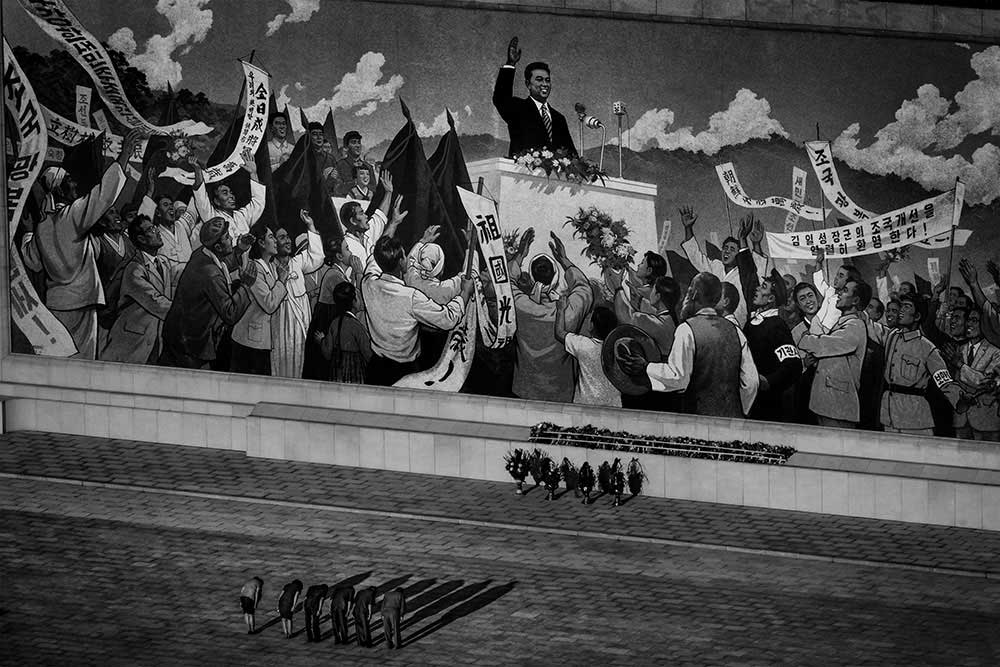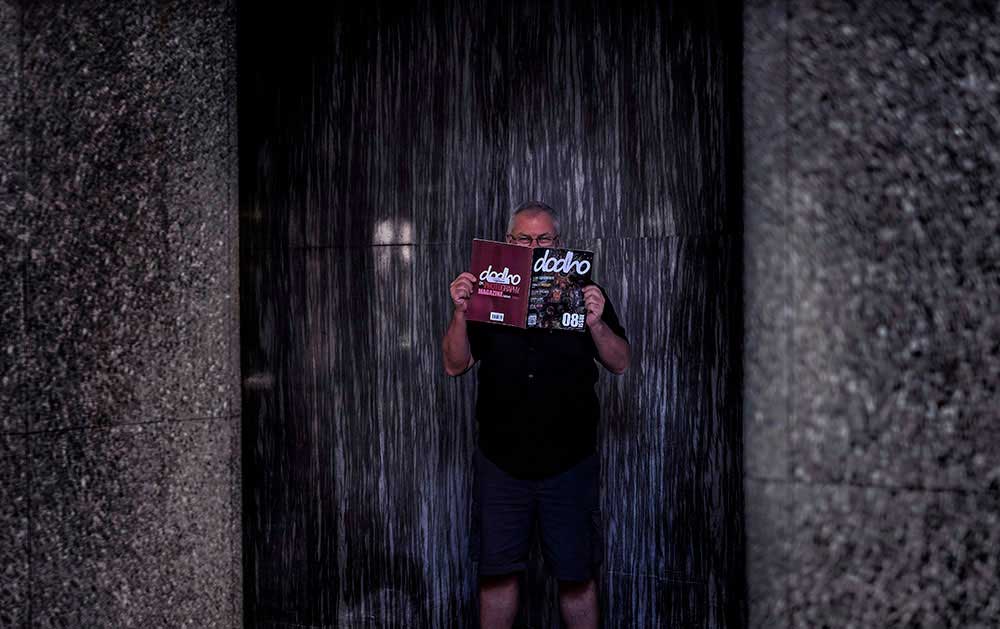Alain Schroeder is a Belgian photojournalist born in 1955. In 1989 he founded Reporters, a well-known photo agency in Belgium. He has illustrated over thirty books dedicated to China, Iran, the Renaissance, Ancient Rome, the Gardens of Europe, Thailand, Tuscany, Crete, Vietnam, Budapest, Venice, the Abbeys of Europe, Natural Sites of Europe, etc.
Belgian book titles include, «Le Carnaval de Binche vu par 30 Photographes», and «Processions de Foi, Les Marches de l’Entre-Sambre-et-Meuse». Publications include National Geographic, Geo, Paris Match,… He has won many international awards including a Nikon Japan award for the Who Will Save the Rohingya series, the TPOTY (Travel Photographer of the Year) award with two series – Living for Death and Kushti, a World Press Photo 1st Prize Sport Stories for the series Kid Jockeys, and participated in numerous exhibitions worldwide. He is represented in Paris by the photo agency HEMIS. [Print Version] [Digital Version][Official Website]
Can you tell us a little about yourself?
I am 63 years old and have been a professional photographer for 40 years.
In 1989, after 10 years freelancing, I established Reporters Photo Agency with two other photographers www.reporters.be. Within a few years, it grew from 3 to more than 20 people doing all types of photography and video. Around 2000, business was getting harder due to the Internet and the rise of digital cameras. While both were great inventions, competition became tougher and more diverse, not only from other agencies but now almost anyone could sell, or try to sell pictures. Prices dropped. This revolution affected magazines and newspapers as well and the money suddenly disappeared. Magazines no longer offered assignments or guarantees and we were forced to explore other sources of revenue like corporate communications and video.
In 2012, I sold my shares in order to travel the world and shoot personal projects focusing on social issues and human interest stories. I have won many awards since including, 1st prize at World Press Photo in the category Sports Stories with the series, Kid Jockeys.
How did you get interested in photography?
I was 17-18 and I spent a lot of time at the library reading fine art books. When I had seen all the books they had about painting, the librarian gave me some photography books. One was the famous French magazine Photo and the first story I liked was made by the Japanese photographer, Kishin Shinoyama. It was a very interesting magazine as it mixed all kinds of photography – fashion, documentary, travel, war, personal work – in one issue. Then I discovered another famous magazine called Zoom and all the classic photographers like Cartier-Bresson, Koudelka,… I was hooked and at school I switched immediately from fine arts to photography classes.
What inspired you to take your “Kim City” project?
It was by coincidence. I went to Pyongyang, North Korea last September for the 70th anniversary of the founding of the DPRK (September 9, 1948) to shoot a story on Taekwando which comes from Korea. The festivities included the Mass Games. It was a rare chance as the games had not taken place since 2013.
The officials had agreed to my project but I was chaperoned and surveilled by two government guides at all times; standard practice for foreign visitors. You are told what to do, what to look at (or not) and what to photograph. Before taking me to the Taekwando location, they drove me around Pyongyang to see the monuments dedicated to their leaders. At first I was very annoyed because I had only one week and wanted to take advantage of every second to shoot my Taekwando story, but there was no choice other than to follow their rules. No room for improvisation. So I decided to make a story on the city without knowing if it would be a complete/interesting story, but everyday brought a few uncommon shots.
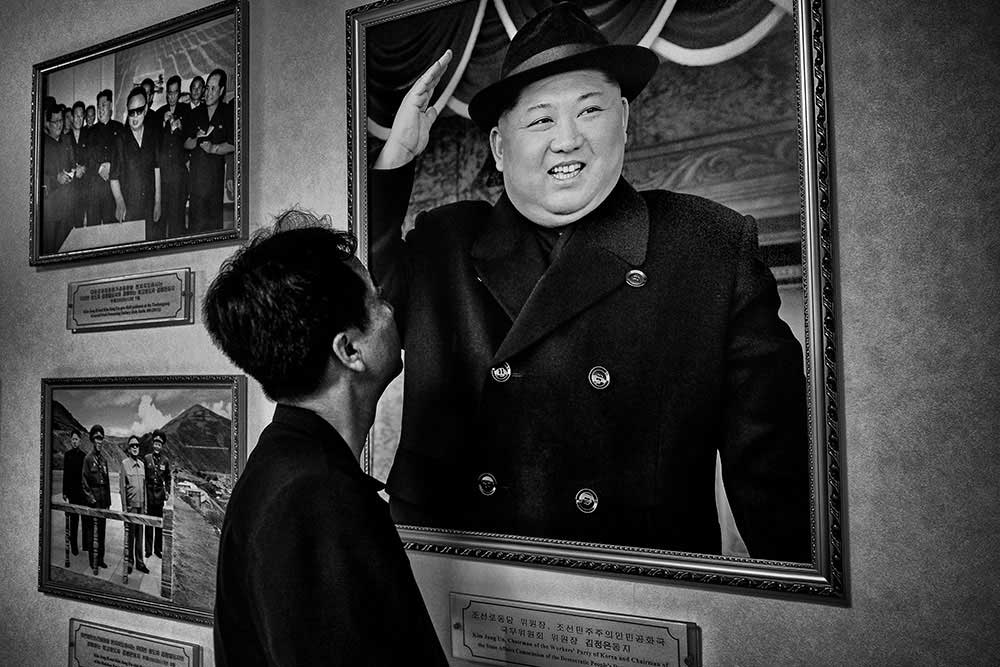
What first drew you to this project? Why did you want to tell this story?
Sometimes it is an article in a magazine or on the Internet, but for North Korea it was an encounter with a photographer who (also) won a prize at the Felix-Schoeller contest in Osnabruck (Germany) in 2017. We talked about practical details for visiting North Korea as a photographer and 1 year later I went.
I took a more artistic approach; still photojournalism, but almost an exercice on how to show a country in a few days of shooting when you have no control over where can go and what you will see, I saw a surreal country and I wanted to show that.
What has been the hardest part of this project?
Nothing was hard but it took 6 months to negotiate the story about Taekwando. I had to make a list of exactly what I wanted to photograph. So I put a lot of effort in trying to describe almost all the pictures and situations I had in mind. The agency in Beijing transmitted this to North Korea, one month later they would receive a request for more details, I would respond, and so forth and so on. When I finally arrived in Pyongyang, my chaperones brought me to 3 different places. Nothing I had asked for (about Taekwando) was available, “We are very sorry sir, that is not possible”. While waiting for the Taekwando shots to happen I decided to take advantage of Kim’s city.
How would you define your general style of photography?
I like to tell stories in a personal, visual way. In Belgium, we have a background of surrealist artists (Magritte, Delvaux) plus the strong influence of the French and Spanish surrealists (Ernst, Dali, …) . They definitely shaped the way I see things. Documentary photographer for 40 years and 25 years as the director of Reporters, one of the leading Belgian photo agencies, have definitively fashioned my approach to photography. I’m most interested in the in-depth reporting of stories relating to people and their environment. Various cultures, modes of living, rituals and customs fascinate me. My work is a mixture of photojournalism, contemporary documentary influenced by my Belgian heritage.
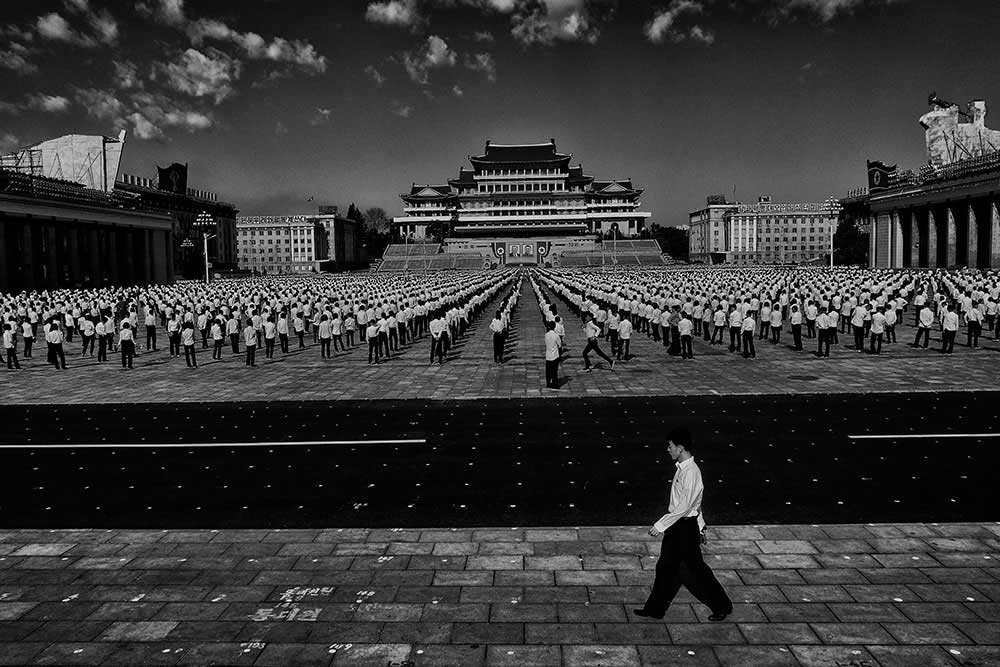
Could you please tell us anything about your technique and creative process?
I use only one camera. At the moment, it is a Fuji XPRO2. I have a spare camera (never used) wrapped in a box in my suitcase. I work with 4 Fuji lenses – 18mm 2, 14mm 2.8, 35mm 1.4 and a zoom 55-200mm 3.5-4.8. I have a Nikon flash SB28 and a small remote control (Pawn Wireless Flash Trigger, TF-362RX) but I use it rarely as the quality of the XPRO2 allows me to take pictures even when it is very dark. I use the flash only when I have an assistant to hold it on the side of the subject. The last time I used it was for the story on Belgian crystal for National Geographic in 2014.
I choose 15 to 20 shots that work together and try to place them in a cohesive order. Once it makes sense and I feel that I’ve got a good story, I start the post-processing work. After, I choose an additional 20 images to broaden the selection. It’s possible to tell different stories based on the editing.
I learned post-processing with b&w film. I was making prints with an enlarger, using hot water to accelerate the developing process sometimes, or developing some parts with a paint brush, exposing others longer or the opposite,… the list goes on. Today, all these techniques exist in Photoshop. The difference is that now you can work in a cafe sipping coffee instead of using dozens of sheets of paper to achieve the desired effect. But those hours, days and nights spent in the darkroom helped me a lot. I know immediately what should be done on a given picture. The best post-processing must be almost “invisible”.
No excessive post-processing approach will fundamentally change the light. When the light is not good you are just adding a trick on top of a picture. The general public might not see or understand it as a trick but professionals will.
Other then those more technical aspects, the main thing is to take a good picture, that’s the goal. The rest (the techique) is easy to learn quickly.
I learned photography with b&w and color slides on analog cameras in the 70s. I know the techniques very well but since then, camera manufacturers have made so many technical improvements that I usually put my camera on P (program) or S (so I can choose the speed). I studied fine arts and over the years I developed a good sense for framing a picture. I feel instinctively where I should place myself to get the best pictures in a given situation. Photography is not made by the camera but rather a little bit by your eyes and mostly by your brain.
In your opinion, what makes a good documentary photographer
The ability to tell a story in 10-15 pictures capturing the essence of an instant with a sense of light and perfect framing.
Whatever the situation, there is always a good picture to be taken. To explain that I have to share an interesting experience I had when I was a sports photographer, in a previous life ;-). I was invited for many years to participate in the making of the book «Roland Garros seen by the 20 best tennis photographers in the world» managed by Yann Arthus-Bertrand, the famous French filmmaker and photographer. In a confined area of Roland Garros, the idea was that every day 20 photographers had to bring back a few good pictures that were immediately displayed on a wall. Yann would select the best ones for the book. Some days you did not even make the wall selection! But every day your colleagues made good pictures sometimes when you had not seen anything special. They might have found a new location, a different way of seeing things; from a higher perspective or at night after the matches. What I want to explain is that the pictures are there, they exist. You have to have ask yourself, how can I make a good picture and where is the best angle, then find the spot and wait. I know that the pictures « exist » in a sense, and if I don’t get them myself another photographer in the same place will find the way to reveal them. There is always a good picture to be taken, you just have to work hard to get it. That idea never leaves me.
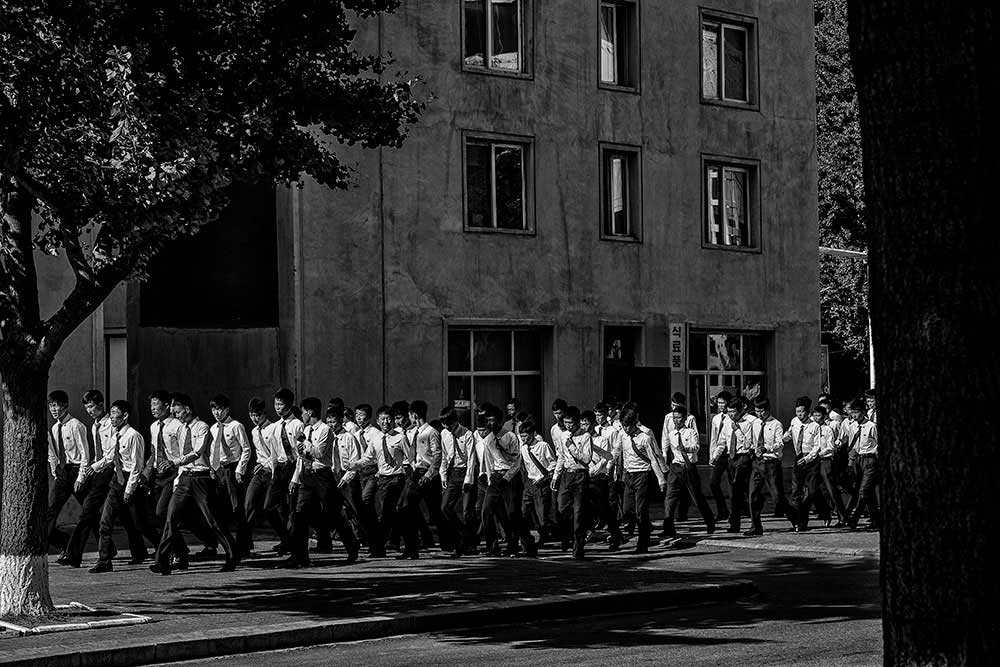
How much preparation do you put into taking a photograph?
I often learn about new stories through books or pictures I see in magazines or on the Internet. I usually collect and store information in folders on my computer and then I do some research. If I feel some personal interest, I just go with a little bit of preparation. I really prefer to discover the story and settle all the details on the spot, then go with the flow. For North Korea, it is impossible to improvise because everything has to be planned in advance but once on the spot…
Sometimes things do not fall into place easily. For my last story, Saving Orangutans in Indonesia (just published in 2019 August issue of National Geographic Holland/Belgium), I tried for 1 year (by writing) to get permission to shoot. Without a positive response, I decided to go to Sumatra where it took 2 more months to build relationships, get specific permission and pass the required medical tests. When I finally got to where I wanted to be, it took another 3 months to get the shots I wanted. Preparation is important but patience and perseverance is key.
What do you think makes a memorable project?
The projects usually become memorable when they have a bad start because you have to show perseverance and very often the time spent rewards you well.
How do you know you got the shot you wanted?
You never know for sure, but now with digital files you can immediately check if there is any emotion in your pictures which was not the case in the analog era. Plus you can anticipate a few corrections in post-production, so you are close to visualizing the final image. And when you shoot, sometimes you get goosebumps when you see what is front of your eyes/camera. Something is amazing either in terms of light, color, emotion or situation. Then you know.
Your idea of the perfect composition?
I am not just looking for perfect composition, I am looking for emotion. I like Koudelka for the poetry in his pictures, Alex Webb for his personal use of color, Raghu Rai an Indian photographer, Guy Bourdin and Steve Hiett in fashion, but I am more struck by a photo rather than a photographer. I like photographers in many different fields as long as their personality comes through in their images. I like when you can feel the photographer behind the picture, not only the subject. I value the emotion and the story in a picture but of course it has to be well composed.
Finally, one last question. What opinion do you have of our print edition?
Great. The quality is very good and you develop the photographers work on 14-16 pages which is interesting for the viewers and allows you to understand the work.
